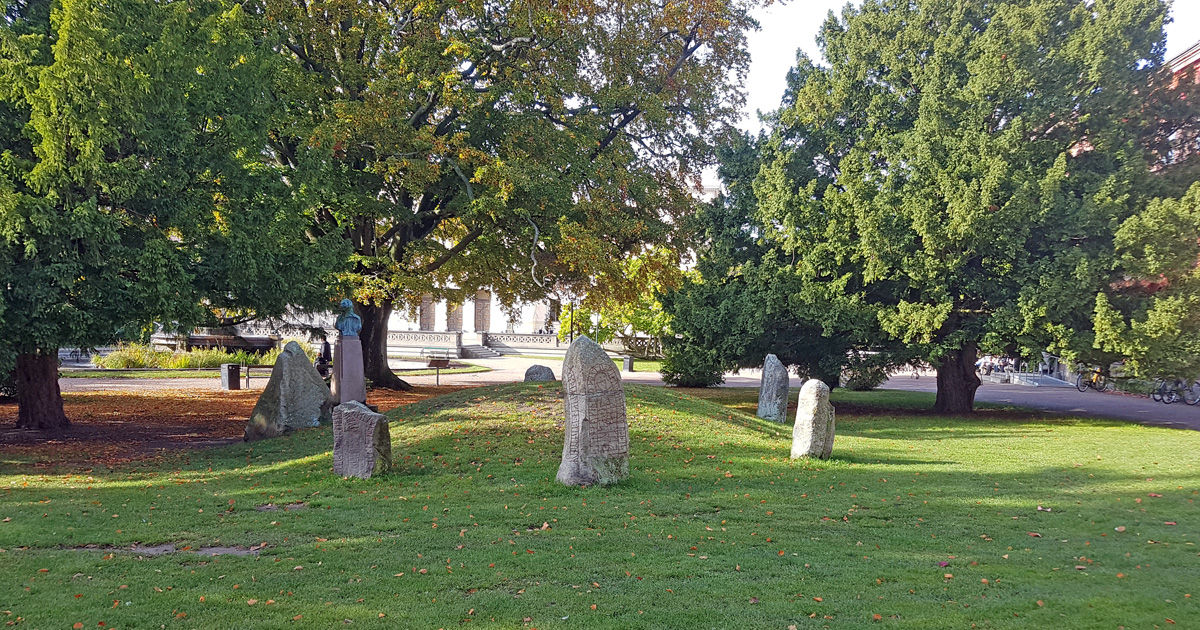Visitor guides about Lund
Tourist Information
• This is Lund
• Our greeters
On this page, you will find more visitor guides about Lund than anywhere else! Those guides
present a large range of tourist information about Lund, the oldest city in nowadays Sweden,
founded by the Danish Viking royals in 964. Lund is one of the most interesting cities when it
comes to culture and history. It is also a student city with one of the largest universities
in the Nordic region, which contributes to making Lund a research and humor city.
Lund was an important Danish city during the medieval times but has been a part of Sweden since 1658 when Scania became Swedish after a peace settlement in Roskilde. During the first 700 years, Lund was the unofficial capital of Denmark due to its importance as archbishopric. The mix of Danish and Swedish culture and history makes the city an interesting destination. Even though Lund has around 100,000 inhabitants today, the medieval city center is quite small, cozy, and walkable, with old architecture and many restaurants.

Tourist information about the oldest city in nowadays Sweden
The visitor experiences are framed like attractions, walks and biking tours. You guide yourself by using the tour guide, developed as mobile friendly web pages. The guides are an important part of the experience since some of what is described are not easily visible if you do not know about it. All visitor guides are free of charge and contain no commercial.
We also offer greeter service in English for smaller groups up to six persons, totally free of charge. Our tourist information is voluntary nonprofit driven by people living in Lund. You are welcome to contact us about our visitor guides or if there are other questions about visiting Lund. Normally, we have short response times.
 The medieval city center as its best a warm and sunny summer day.
The medieval city center as its best a warm and sunny summer day.
Experience the viking age in Lund
Runes were the Northerners’ first alphabet. The letters, or rather the runes, were carved in wood, bone or stone. Learn about the runic alphabet and its different runic characters. Then, you can try to read the text on some of the runestones in Lund.
Visitor guides
-
The Runestone hillock, attraction
½ hour
The Runestone hillock is a monument created in 1868 as a gift to Lund University 200th anniversary. The six runestones standing around the small hillock were carved during the Viking Age, in the late 900s and early thousands. This visitor guide tells about the short messages that are left on the stones.
 The runestone hillock with its six runestones.
The runestone hillock with its six runestones.
Experience the medieval Lund
During the Viking and Middle Ages was Lund an important town for the Church. At the end of the Viking era, around year 1060, there were nine wooden churches and two churches made of stone, and some sort of monastic activity in the city. In 1103, when Lund became an archbishopric for a governorate which included the whole Christianized Scandinavia, even more churches were built. Almost 200 years later, there were 22 churches and four monasteries in Lund. After the reformation, which took place 1536 in Denmark and is seen as the end of the Middle Ages, most of the churches and all monasteries were teared down. Today, only two of those churches still remains, the Cathedral and the Cloister church.
Visitor guides
-
The Lund Cathedral, attraction 1 hour
The Cathedral was of course the most important church and dominated the medieval city of Lund. Today, it is the most visited Cathedral in Sweden. In this visitor guide you will find some pictures that help you experience the beautiful Cathedral. -
The Cloister church, attraction 1 hour
The only remining church from the medieval time, except the Cathedral, is the small but lovely Cloister church. It was a monastery for Benedictine nuns. In this visitor guide you will find some pictures and description about it. -
The medieval City Wall, walk 2-4 hours
In the 1130s, a city wall was built around the 84-hectare urban area which constituted the whole city of Lund for almost 900 years. An interesting way to see Lund as a tourist or visitor is to walk alongside the city wall that surrounded Lund in the medieval. There are many interesting places to see along the way.
 Today, Lund Cathedral is the most visited Cathedral in Sweden.
Today, Lund Cathedral is the most visited Cathedral in Sweden.
Experience the Lund University city
Without the University, Lund will not be this cozy city. The University is one of the largest in the Nordic countries with about 47 000 students and more than 8 800 employees. The probably best way to explore the university city of Lund is to visit the activities during April Last and May First.
• Experience Lund University city
Visitor guides
-
The University’s History, stroll 1 hour
A walk describing how Lund became a university city and where the teaching was taken place during the first 200 years. -
The University Main Building,
attraction ½ hour
The magnificent white University Main Building is one of Lund's most photographed buildings. It is is closed for renovation right now but this visitor's guide shows pictures of what it looks like inside. -
Lund’s Most Amusing Attractions, stroll 1 hour
Humor, parody, satire, and absurd comedy have a long tradition in Lund thanks to its university and all students. This is a walk passing a number of humoristic installations made by the students of Lund University.
Events
-
April Last and May First, event 2 days
The best way to explore some traditional university activities is to spend April Last and May First in Lund. During those days there are a lot of activities like the improvised pick-nick in Lund's City Park, the donning of the Caps ceremony, honouring the Vice-Chancellor on University Plaza, and listening to the Lund’s Student-Singers greeting springtime from the stairs at the University main building. -
The Lund Carnival 2026, event 3 days
You almost have to experience the Lund Carnival, the absolute largest event in Lund. The carnival is organized by about 7,000 students at Lund University in mid-May every four years. The next time will be in 2026, tentatively May 22 to 24. About 500,000 visitors come to the city during the three days the event takes place, from Friday to Sunday.
 On May First everyone can visit when the students honor the Chancellor on University Plaza in
Lund.
On May First everyone can visit when the students honor the Chancellor on University Plaza in
Lund.
Experience the Battle of Lund Lund
After 700 years as a Danish city, Lund became a Swedish in 1658, but it was a troubled time with many wars. The event that perhaps affected Lund the most was the Battle of Lund. About 3,000 soldiers were killed on the battlefield north of Lund, and a lot of people died in the weeks before the battle, due to bad conditions.
Visitor guides
-
The Battle of Lund, biking tour 5-6
hours
A full-day excursion passing 14 places where different parts of the Battle of Lund took place on December 4, 1676. On the tour you pass lots of beautiful countryside along the sparse traffic cycle paths.
Further ways to discover Lund
Today, there is almost 100 000 inhabitants in Lund city, still it is cozy walking around in the small medieval city center with its old blocks, mixed architecture and a lot of cafes and restaurants.
Visitor guides
-
All Saints' Church in Lund, attraction
½ hour
The beautiful All Saints' Church, which was inaugurated on All Saints' Day, November 1, 1891. The church is a very beautiful and worthwhile masterpiece by the Lund Cathedral architect Helgo Zettervall. -
The old blocks of Lund, stroll 1-3 hours
A walk along some of the old and picturesque houses and blocks, with paving stones and blooming hollyhocks, lavender and roses during the summertime. -
Market Places in Lund, attraction 1
hour
There have been various kinds of market trade in Lund for more than a thousand years. This visitor guide tell about places in Lund where trading has been conducted in the past, and where there are trade and markets today to visit in Lund. Reading this visitor guide will take you on a time journey through Lund as a trading city. -
The Lund Market Hall, attraction ½
hour
The more than 100-year-old Market Hall is one of the coziest places in Lund. In this visitor guide you find information about the history and some of the shops located there nowadays. It also tells about Lund's two famous sausages, Knake and Lunna Melle. -
Lilacs in Lund, stroll 1 hour
A walk in the park Lundagård and the old university area when the lilacs is blooming as its best. -
Allotment areas in Lund, biking tour 2 hours or
more
Between first of April and last of September all of the allotments in Lund are opened for visitors every day between 08.00 and 20.00. There are lovely small cottages, and during summertime, a lot of plants and blossoms. The allotments are also historically interesting, four of them more than one hundred years old. -
Filming locations in Lund,
strolls 2-4 hours
Several films and series have been filmed in Lund. There are so many varied and beautiful environments here in Lund, from the beautiful old city center with the old blocks to all the different environments of the university. Here you will find visitor guides about the places you can see in some movies that have been filmed in Lund.
 There are eighteen allotment areas like this one in Lund, lovely to visit in summer time.
There are eighteen allotment areas like this one in Lund, lovely to visit in summer time.
![[Bild]](/common/img/default.png)